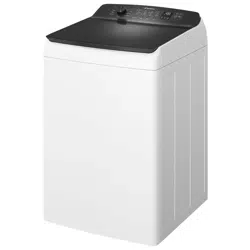Documents: Go to download!
User Manual
- User Manual - (English)
- WWT8084J7WA - - Specifications Sheet - (English)
- Spec Sheet (web) - (English)
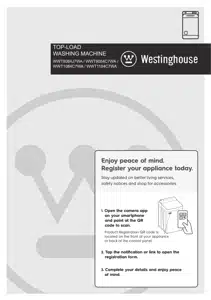
- PRODUCT DESCRIPTION
- Parts
- CONTROL PANEL
- DAILY USE
- WASHING HINTS
- CARE AND CLEANING
- TROUBLESHOOTING
- TECHNICAL DATA
- INSTALLATION
Table of contents
User manual Washing Machine
PRODUCT DESCRIPTION
Parts

Detergent/Bleach/Dispenser
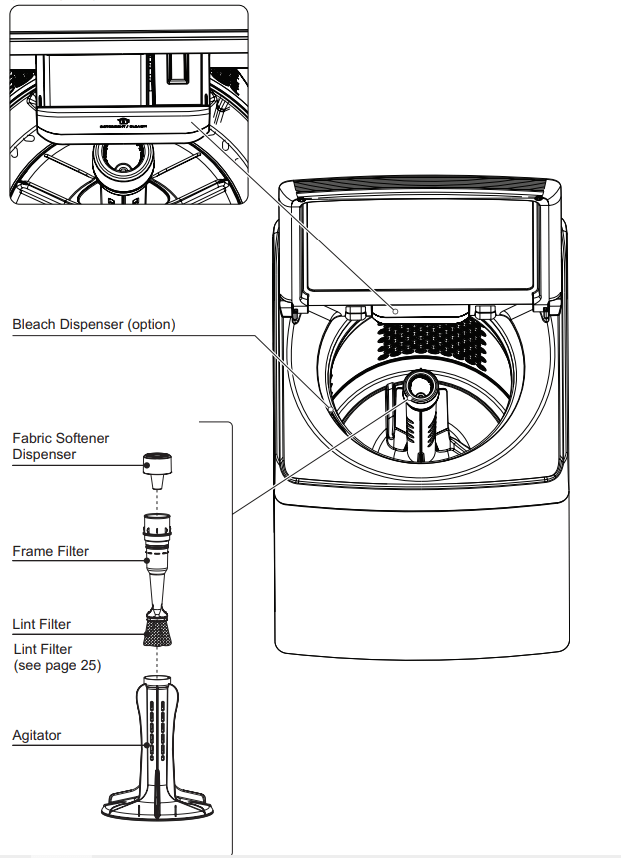
Product Features - Auto sensing water level
Auto sensing is a feature where the washer fills automatically with water to just the right level for your clothes load.
You do have the option to manually set the water level if you wish.
We recommend you use the auto sensing water level option to ensure there is just the right amount of water for the wash load in the machine. In other words, it will usually give you the best wash while also being the most efficient in terms of water usage.
At times during a wash, it may appear your machine is either doing nothing or intermittently it is only gently vibrating/ jiggling/agitating.
This is because your machine could be:
- In auto sensing test mode and the machine is determining the correct amount of water for your wash.
- At a drain stage of the wash program and the machine is allowing time for water to flow the washbowl from to the out bowl.
- Engaging or disengaging the drive clutch mechanism. Wait a short time, your washing machine will complete the above tasks and continue with the wash.
The amount of water for auto is factory set at an optimised level. You can adjust the Auto level up or down by a small amount.
Power Failure Recovery
- When there is power failure while the machine is washing or rinsing or spinning. The machine tries to save the settings at which stage the machine is doing and then when the power returns back the machine will start washing from the stage where it is left off.
PreMix  : This feature helps to dissolve and activate the active ingredients of the detergent, by blending the detergent with the water (except Fast 20 program), before dispensing into the tub and onto the clothes.
: This feature helps to dissolve and activate the active ingredients of the detergent, by blending the detergent with the water (except Fast 20 program), before dispensing into the tub and onto the clothes.
Dual Jets System: Dual jets help to improve cleaning results by spraying directly on the clothes and give a more thorough rinse-out of stains and dirt.
CONTROL PANEL
Control Panel Description
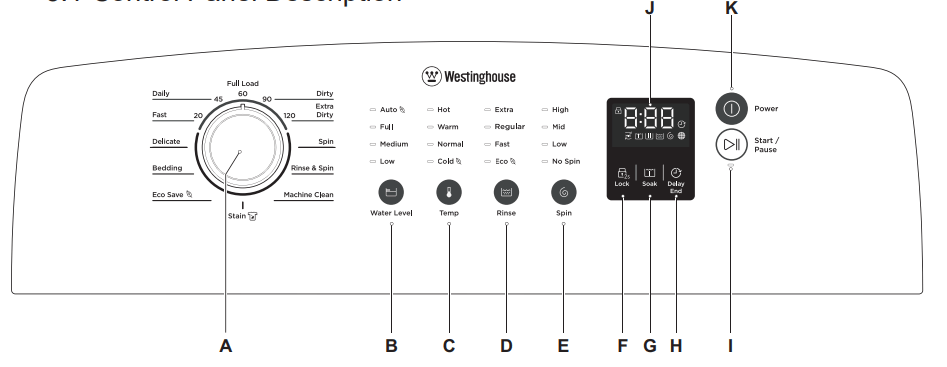
A: Program knob
B: Water Level touchpad
C: Temp touchpad
D: Rinse touchpad
E: Spin touchpad
F: Child safety lock option (press and hold touchpad about 2 seconds)
G: Soak touchpad
H: Delay End touchpad
I: Start/Pause touchpad
J: Display
K: Power touchpad
Press the touch buttons with your finger in the area with the symbol. Do not wear gloves when you operate the control panel. Make sure that the control panel is always clean and dry.
Display

A: PreMix Phase icon
B: Soak Phase icon
C: Wash Phase icon
D: Rinse Phase icon
E: Spin Phase icon
F: Clean Filter Reminder icon
G: Child safety lock option icon
H: Program Duration / Delay End Time / Alarm Code
I: Delay End icon
Options
Water Level Touchpad 
- Choose the water level by pressing the “Water Level” touchpad.
- Use only the amount of water you need for the wash load.
- Please refer the to program table on page
Temp Touchpad 
-
For each wash program your washing machine automatically selects a suitable fill water temperature. If you want to use a different wash water temperature, press the Temperature button repeatedly
- The water temp lights will tell you the temperature for each press of the button
- You have four temperatures to choose from Hot, Warm, Normal and Cold.
- The temperature of warm water will depend on the temperature and pressure of your hot and cold water supplies. The recommended temperature for warm is 35°C.
- You can adjust the flow rate of the water supplies to adjust the Warm temperature. All rinse water temperatures are cold.
- Always check your label for the washing temperature symbols which the International Care Labelling Code now uses

If you have a cold water connection ONLY and the hot inlet valve is capped off (refer installation instructions) you must select Cold washes only.
Rinse Touchpad  : Pressing the Rinse touchpad to choose the rinse type for your wash load. For most washes, the machine automatically fills the full tub of water for a rinse. Rinse Touchpad There are four rinses to choose from Extra, Regular, Fast and Eco to remove the detergent from the clothes.
: Pressing the Rinse touchpad to choose the rinse type for your wash load. For most washes, the machine automatically fills the full tub of water for a rinse. Rinse Touchpad There are four rinses to choose from Extra, Regular, Fast and Eco to remove the detergent from the clothes.
- Extra rinse - 2 rinses cycles.
- Regular rinse - 1 rinse cycle.
- Fast rinse - Spraying water 3 rinses cycles.
- Eco - Spraying water 4 rinses cycles.
How does Eco Rinse work?
- When Eco rinse is used, rinse water is sprayed into the washbowl in pulses. After each pulse the washbowl will spin to remove detergent laden water from the clothes.
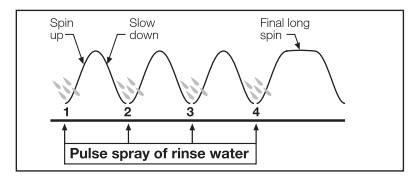
- The machine will go through a series of maximum 4 pulses spray and short spin cycles in this manner, depending on program selection, followed by a final long spin that removes the water from the clothes to complete the full wash program.
Note:
- Compare this with Regular rinse where much more water is used.
- Regular rinse, water enters the machine filling up to the wash water level selected. The washer agitates and finally empties the rinse water through the drain hose.
- Extra rinse, this is a special option for those people who suffer from allergies, this extra rinse will provide 2 rinses to ensure all detergent residue has been removed.
- Select Regular rinse if you are going to use fabric softener.
- Regular rinse ensures the fabric softener is correctly dispensed and thoroughly removed from your clothes during rinsing.
Spin Touchpad : Press this touchpad to select the spin speed or no spin, if you want your laundry to be spun at a speed different from the one proposed by the washing machine. The speed of spin level are:
: Press this touchpad to select the spin speed or no spin, if you want your laundry to be spun at a speed different from the one proposed by the washing machine. The speed of spin level are:
- High, about 800 rpm ;
- Mid, about 650 rpm ;
- Low, about 550 rpm.
- No Spin, 0 rpm.
Soak Touchpad 
- This option allows you to soak heavily soiled clothes at the beginning of the wash. To do this, press the Soak touchpad to select the soak time
- The lid must be closed to allow Soak functions to operate. The machine will agitate for short periods. At other times, the clothes are soaking and the machine will be doing nothing.
Delay End Touchpad 
- Before you start the program, this option makes it possible to define the end of the washing program from minimum of 1 hour to maximum of 20 hours.
- Press the Delay End touchpad to choose the end time as you wish. The display shows the number of hours.
- This option must be selected after choosing the wash program, and before pressing the “Start/Pause” touchpad.
- For example, if the program duration of your selected program is 3.20 hours and you define the “Delay End” time to 6 hours. This means your wash program will finish in 6 hours. (See diagram)
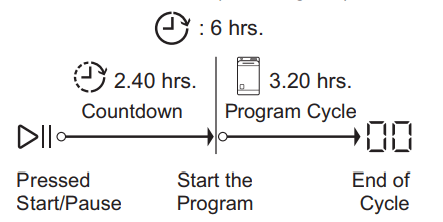
- After selecting Delay End time, press Start/Pause touchpad to start the program. Machine will then countdown and update time on the display every hour until it reaches the starting point of the wash cycle.
- If you wish to modify or cancel Delay End option after starting the program, follow the steps below: set the washing machine to PAUSE by pressing “Start/Pause” touchpad; deselect this option by pressing “Delay End” touchpad repeatedly till the display shows delay time “ ”; press the “Start/Pause” to start the program.
Start/Pause Touchpad 
- To start the selected program, press the “Start/Pause” touchpad.
- If you have started your wash and you wish to stop it for some reason, press the “Start/Pause” touchpad to enter PAUSE mode
- To restart the program from the point at which it was interrupted, press the “Start/Pause” again.
DAILY USE
Starting Your Washing Machine
- Connect the mains plug to the mains Bleach socket.
- Turn the water tap on.
Load The Washing Machine
When loading the clothes into your washing machine, there are four things to remember:
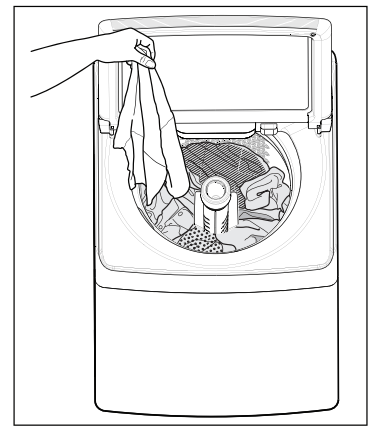
- Clothes must be loaded evenly around the agitator. For best results, load small items first, followed by large items.
- Clothes must not be wrapped around the agitator.
- The washing machine must not be overloaded. Clothes must be able to move during wash.
- The load should contain only three or four large items, for example sheets. The rest of the load should be small items. A mixed load of large and small items will wash cleaner than a load of all large items.
Add The Detergent/Bleach
Powder / Liquid Detergent / Connect the mains plug to the mains Bleach
- Pull the dispenser drawer forward out from its position.

- Measure the correct amount of powder or liquid detergent by following the recommendations on the package.
- Pour it into the detergent dispenser drawer.
- Put the dispenser back into its recess.
Liquid Detergent (Option) - Pouring onto the clothes.
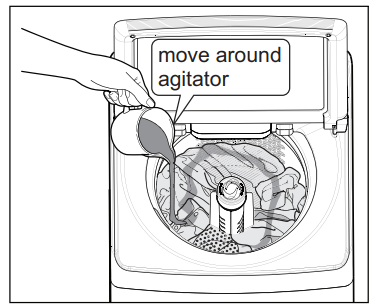
- Measure the correct amount of liquid detergent by following the recommendations on the package.
- Mix detergent in one litre of water.
- Add the pre-mixed detergent to the wash load. NOTE: When you use the liquid detergent. Do not use gelatinous or thick liquid detergents.
Add Fabric Softener
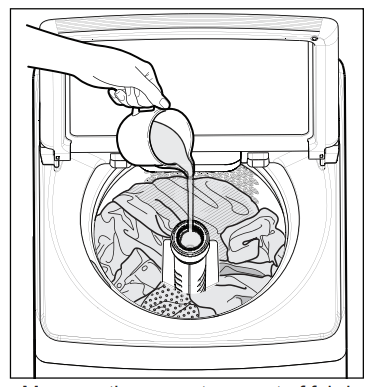
- Measure the correct amount of fabric softener by following the recommendations on the package.
- Mix softener with an equal amount of warm water but only mix enough to fill to the line marked inside the cup. The softener cup holds 75ml.
- Pour the mixed softener into the cup on the top of the agitator. Do not overfill the cup. Do not spill fabric softener on the clothes as it may stain them.
NOTE
- The softener amount used must not exceed the “MAX” mark in the cup.
- If you use thick softeners it is recommended to dilute with water.
- Residues of softener and water may remain in the cup. It is recommended to clean the cup regularly to remove any residue.
Adding Bleach (Option)
Bleaching of clothes can help to remove stains, heavy soiling and to kill bacteria.
Oxygen Type: This is generally a powder type bleach. Pour it into the detergent dispenser drawer or mix the required quantity with water and pour down the bleach hole in the top of the washing tub during the fill when there is some water in the
Chlorine Type: This type of bleach should not be mixed with detergent. Mix the bleach with water as per the instructions on the container. How to soak with bleach, proceed as follows:
- Turn Program Selector to a Full Load 60 position.
- Press the Start/Pause touchpad to commence water fill.
- Pour the bleach solution down the hole in the top of washing tub during fill when there is some water in the washbowl by tilting the washing tub as picture below
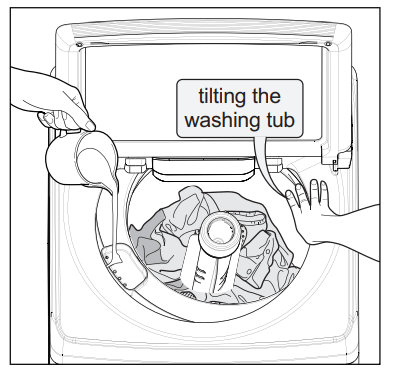
- Allow the machine to agitate for a few minutes, then let it stand for the required time by pressing Start/Pause touchpad to pause the machine.
- When soaking bleach reached the required time, turn Program Selector to Rinse & spin position and press the Start/Pause touchpad to empty the wash bowl.
Setting a Program
1. Press Power  touchpad, turn the program selector to the required program.
touchpad, turn the program selector to the required program.
- Your washing machine is now in STAND-BY-MODE and ready to wash your clothes.
- The relevant light will light up.
- The buzzer will sound.
- The selector dial can be turned either clockwise or anticlockwise.
- Once you selecte a program, the program selected will stay at that position for the whole of the cycle.
- The display shows the program duration.
If the settings shown on the control panel are what you want to use, press the Start/Pause touchpad to start your wash.
2. If you want your laundry to be washed with functions different from the one proposed by the machine, press Water Level, Soak, Rinse and Spin option touchpads. NOTE: Different functions can be combined which is dependent on the program selected. When these touchpads are pressed, the corresponding pilot lights come on.
3. If you want to define the end of the washing program, press the “Delay End” touchpad repeatedly to choose your machine end time.
Starting a Program
- To start a program, press the Start/Pause
 touchpad, a default program duration will be displayed on the screen.
touchpad, a default program duration will be displayed on the screen. - NOTE: When you select the Rinse & Spin program, there will be a delay of at least 2 minutes before the washing machine starts to spin.
- This delay is a drain out period to ensure the bowl is empty of water, which is necessary before spin commences. Even though you may have only put wet clothes into an empty bowl, the delay before spin will still occur to be safe and to protect your washing machine.
Interruption Of A Program
- If you have started your wash and you wish to stop it for some reason, press the Start/Pause touchpad to enter PAUSE mode.
- The time remaining is blink and the Start/Pause LED will start flashing. Press the Start/Pause again. The program will continue.
Changing A Program
- Changing a running program is possible only by switching off the appliance. Press the “Power” touchpad to cancel the program and to turn off the appliance. Press the “Power” touchpad again to start the appliance.
- Now you can set a new wash program and change any available options. Press Start/Pause to start the new program.
Changing The Options:
It is possible to change only some options after the program has started.
- Press the Start/Pause touchpad to enter PAUSE mode.
- Change the options
- Press Start/Pause touchpad again. The program will continue.
At The End Of The Program
- The appliance stops automatically.
- The display will show
 and flashing with 3 consecutive long beeps.
and flashing with 3 consecutive long beeps. - Press Power touchpad to turn off the machine
- Remove the laundry from the appliance. Make sure that the washing tub is empty
- Keep the lid ajar, to prevent the mildew and odours.
- Turn off the water tap.
WASHING HINTS
These Washing Instructions are of a general nature and you should get good wash results by following them.
However, due to the variables of fabric types, soil levels, detergent types and available program settings you may find some combinations of these which do not always result in the perfect wash.
If for example you see residuals of detergent or soils on some items, please read the section Residues on washed items paragraph.
Over time you will learn what is the best set-up of programs, detergent and load sorting for different load types and soils
Sort Your Washing Into Separate Wash Loads
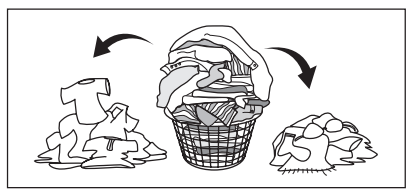
- Each load of washing should contain clothing which needs the same washing conditions. For example, you should not wash delicate clothes with very dirty work clothes.
- Colour fast and non-colourfast fabrics should be separated. Knowing the type of fabrics you have and how dirty they are will help when you make selections from the wash program options.
- Some fabrics are lint collectors and can pick up lint, dirt and colour from other fabrics which are lint producers. Some examples are listed below:
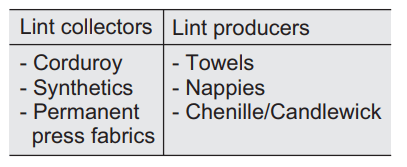
- Never wash whites and coloureds together. Whites may lose their “whiteness” in the wash.
- New coloured items may run in the first wash; they should therefore be washed separately the first time.
- Make sure that no metal objects are left in the laundry (e.g. hair clips, safety pins, pins).
- Button up pillowcases, close zip fasteners, hooks and poppers.
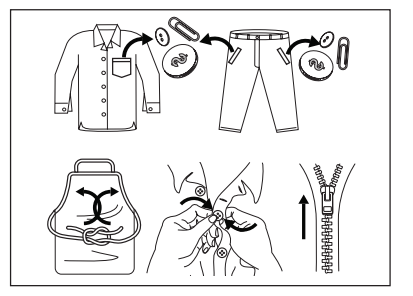
- Tie any belts or long tapes.
- Remove persistent stains before washing.
- Rub particularly soiled areas with a special detergent or detergent paste.
- Treat curtains with special care.
- Wash bras, pantyhose and other delicates in a mesh laundry bag, which you can purchase from your supermarket.
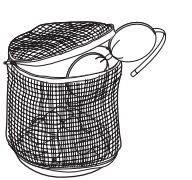
- Remove hooks or tie them up in a bag or net.
Pre-treatment Sprays And Stain Removers
WARNING!
- Pre-treatment sprays and stain remover can damage plastic components on your washing machine
- If you use pre-treatment sprays or stain removers, apply them to the clothing well away from your washing machine.
Detergent
Good washing results also depend on the choice of detergent and use of the correct quantities to avoid waste and protect the environment.
Although biodegradable, detergents contain substances which, in large quantities, can upset the delicate balance of nature.
The choice of detergent will depend on the type of fabric (delicates, woollens, cottons, etc.), the colour, washing temperature and degree of soiling.
- Don’t use the wrong type of detergent. You must use a low sudsing detergent designed for front load washing machines or high efficiency top loaders, such as Cold Power for Front Loaders and High Efficiency Top Loaders or detergents labelled “Matic”.
- Don’t use soap-based products in your washing machine.
- Don’t use too much detergent. This can result in excessive suds that can cause low spin speeds, poor rinsing and overloading the motor during spin stages of the wash program.
- Don’t use too little detergent because you will get a poor wash. If you think you need more, increase dosages by only small amounts to avoid excessive suds.
Quantity of detergent to be used: The type and quantity of detergent will depend on the type of fabric, load size, degree of soiling and hardness of the water used. Water hardness is classified in so-called “degrees” of hardness. Information on the hardness of the water in your area can be obtained from the relevant water supply company, or from your local authority. Follow the product manufacturers’ instructions on quantities to use.
- Not enough washing powder causes: the wash load to turn grey, greasy clothes.
- Too much washing powder causes: sudsing, reduced washing effect, inadequate rinsing.
- Use less detergent if: you are washing a small load, the laundry is lightly soiled, and large amounts of foam form during washing.
A Guide To Stain Removal
- Stubborn stains may not be removed by just water and detergent. It is therefore advisable to treat them prior to washing.
- Blood: treat fresh stains with cold water. For dried stains, soak overnight in water with a special detergent then rub in the soap and water.
- Oil based paint: moisten with benzine stain remover, lay the garment on a soft cloth and dab the stain; treat several times.
- Dried grease stains: moisten with turpentine, lay the garment on a soft surface and dab the stain with the fingertips and a cotton cloth.
- Rust: oxalic acid dissolved in hot water or a rust removing product used in cold water. Be careful with rust stains which are not recent since the cellulose structure will already have been damaged and the fabric tends to hole.
- Mould stains: treat with bleach, rinse well (whites and fast coloureds only).
- Grass: soap lightly and treat with bleach (whites and fast coloureds only).
- Ball-point pen and glue: moisten with acetone (*), lay the garment on a soft cloth and dab the stain.
- Lipstick: moisten with acetone (*) as above, then treat stains with methylated spirits. Remove any residual marks from white fabrics with bleach.
- Red wine: soak in water and detergent, rinse and treat with acetic or citric acid, then rinse. Treat any residual marks with bleach
- Ink: depending on the type of ink, moisten the fabric first with acetone (*), then with acetic acid; treat any residual marks on white fabrics with bleach and then rinse thoroughly.
- Tar stains: first treat with stain remover, methylated spirits or benzine, then rub with detergent paste.
CARE AND CLEANING
Your washing machine will give you long and trouble-free service, if you follow the instructions in this section.
These instructions show you how to care for your washing machine.
What To Do After You Have Finished Your Washing.
- Press the Power button to turn off the machine
- Switch off the electricity at the power point.
- Turn off the water taps. This will extend the life of the inlet hoses.
- Leave the lid open for a while. This allows time for moisture inside the washing machine to evaporate and for any odours to disperse.
Cleaning The Lint Filter:
Lint is a collection of threads and fluff which comes off your clothes during washing. Your washing machine collects this lint in the lint filter. It is important to clean out this lint filter preferably after each wash. How to clean the lint filter:
- Remove the softener dispenser cup and filter column from the centre of the agitator
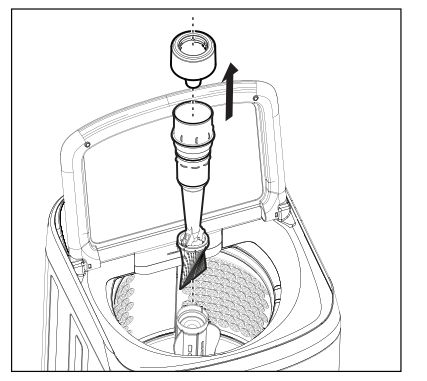
- Unclip the filter bag from the column

- Turn the bag inside out and remove the lint.

- Wash the filter bag and dispenser cup in hot water.
- Reassemble the filter to the column and place it back in the centre of the agitator.
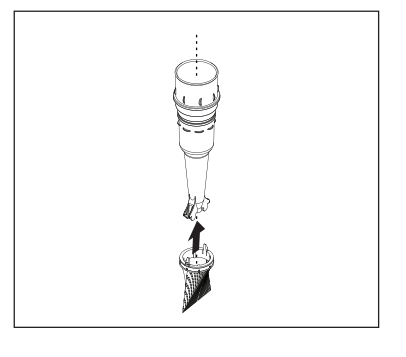
Cleaning The Dispenser:
The dispenser needs to be cleaned regularly, preferably after each wash. Inspect the dispenser after each wash to see if there is any residue of detergent. To do this proceed as follows:
- Remove the dispenser drawer from its places. Pull out the dispenser drawer until it stops then lift up and pull out from the recess.
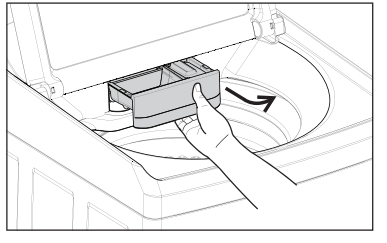
- Clean the dispenser drawer with water and a brush, e.g. an old toothbrush.
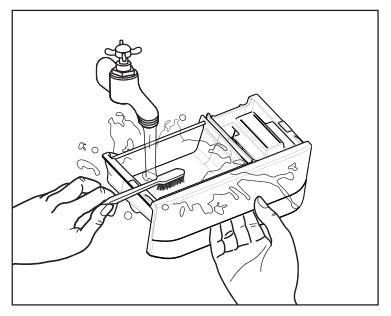
- Dry the drawer.
Cleaning The Drawer Recess
- Having removed the drawer, use a small brush to clean the recess, ensuring that all washing powder residue is removed from the upper and lower part of the recess. Replace the drawer and run the rinse program without any clothes in the drum.
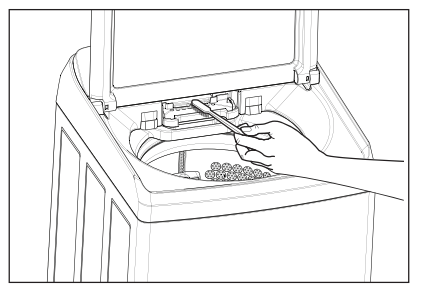
Cleaning The Water Inlet Filter:
If your water is very hard or contains traces of lime deposit, the water inlet filter may become clogged. It is therefore a good idea to clean it from time to time. To clean the water inlet filters:
- Close the water tap.
- Remove the water inlet hose from the water tap.
- Clean the filter in the inlet hose with a stiff brush.

- Remove the inlet hose behind the appliance.

- Clean the filter in the valve with a stiff brush or a towel.

- Install the inlet hose again. Make sure that the couplings are tight to prevent leakages.
- Open the water tap.
Cleaning Your Washing Machine
To clean the inside and outside of your washing machine you should:
- Wipe the surface with warm water.
- Wipe dry with a soft cloth.
Important: Never use solvents, alcohol, aerosol cleaners, spray pack cleaners, glass cleaners, metal polishes, caustic materials, scourers or general household cleaners on or near the top panel and lid, control panel or other parts of your washing machine.
Cleaning Stains In The Washbow
Stains in the wash bowl can be caused by:
- metal objects such as bobby pins, dressmaking pins and nails;
- salt;
- body oils and grease from very dirty or sweaty clothes being deposited around the top of the washbowl;
- excessive foam during wash if incorrect or too much detergent is used.
Important: Check all pockets before loading clothes into your washing machine. Don’t leave wet clothing (especially swimwear) in the bowl for too long before you wash it.
How To Clean the Stainless Steel Wash Bowl :
- Wipe with a cleaning product which is marked suitable for stainless steel.
- Oily deposits can be removed by wiping surfaces with a mild dishwashing detergent and warm water.
Important: Never use bleach cleaners or steel wool to clean the stainless steel washbowl.
TROUBLESHOOTING
Possible Failures
- DO NOT call for service until you have checked the points listed below.
- If you call for service and there is nothing wrong with your washing machine, you will have to pay for the service call.
- You will have to pay even when your washing machine is under warranty. Before you call for service, check the points in the table below.
- If after all checks, the problem persists, contact your local Service Centre.
1. Machine not working
- Power not switched on.
- Switch on power point.
- No electricity supply through the power point.
- Check the power point with another appliance.
Display Code

- Water taps not turned on.
- Turn on taps.
- Water taps not turned on.

- Out of balance switch off.
- Open lid, redistribute load and close lid.
- Out of balance switch off.

- Lid not fully closed.
- Close lid and press Start/Pause to resume operation.
- Lid not fully closed.

- The main supply is unstable.
- Wait until the main supply is stable and the appliance automatically starts operating
- The main supply is unstable.
2. Machine has washed load but will not spin.
Display Code

- Out of balance.
- Open lid, redistribute load, close lid. Lid not fully closed.
- Out of balance.

- Close lid and press
- Start/Pause to resume operation.
- Close lid and press
3. Water in wash bowl.
Display Code

- Drain hose blocked.
- Check drain hose for blockage. Wait a short while, the wash will continue.
- Drain hose blocked.
4. Will not fill with water.
Display Code 
- Water taps not turned on.
- Turn taps on.
- Inlet hoses blocked.
- Clean tap filters/washers
5. Machine goes out of balance or vibrates excessively when spinning.
Display Code 
- Machine not level.
- Make the machine level.
- Levelling feet not adjusted.
- Adjust feet to touch the floor.
- Clothes not evenly distributed.
- Redistribute clothes evenly
6. Water on floor.
- Loose inlet hose connections.
- Check connections at taps and rear of machine.
- Loose drain hose connections.
- Check connections at rear of machine.
7. Clothes still dirty after wash program.
- Not enough or no detergent.
- Check detergent use and rewash clothes.
- Too many clothes on load.
- Remove some clothes and rewash.
- Incorrect wash program.
- Reselect program and rewash.
8. Scraping noise on spin.
- Bra wire or other thin items caught between inner and outer washbowls.
- If the item is visible, remove it with pliers. Use a wash bag in future.
9. Humming, clicking and other noises
- Bowl rotation at start of wash.
- Normal noise.
- Brake activation when stopping after spin.
- Normal noise.
Troubleshooting Fault Displays
When the washing machine detects a problem that requires your attention, you will be alerted. The machine will warn you of this problem by displaying a fault code in the digital display, accompanied by “Beeping”.
Error code and the possible fault information are described in the following table
1. Display Code 
- Difficulties in water fill for washing
- Tap closed
- Water flow too low
- Water inlet valve defective
- Machine system leaking
- Drain hose installation wrong
- Pressure sensor defective
- Wiring or main board defective
- Water leakage
- Machine system leaking
- Drain hose installation wrong
- Pressure sensor defective
2. Display Code 
- Difficulties in draining for washing
- Drain system blocked up
- Drain pump / Drain valve defective
- Pressure sensor defective
- Wiring or main Board defective
- Drain pump triac failure
- Drain pump defective
- Wiring, connector or main board defective
3. Display Code 
- Pressure sensor faulty
- Pressure sensor defective
- Wiring or main Board defective
- Pressure sensor calibration problems
- Water inlet valve defective
- Pressure sensor defective
- Drain system blocked up
- Drain pump / Drain valve defective
- Wiring or main board defective
- Water Overload
- Water inlet valve defective
- Pressure sensor defective
- Wiring or main board defective
4. Display Code 
- Motor problems system
- Motor defective
- Motor Wiring or Motor Control board defective
- Overload condition
5. Display Code 
- UI -MB communication error
- Wiring defective, or UI, MB board defective
6. Display Code 
- Power supply frequency out of limits
- Wrong or disturbed Power Supply line.
- Main board defective
- Power supply voltage too high
- Wrong or disturbed Power Supply line.
- Main board defective
- Power supply voltage too low
- Wrong or disturbed Power Supply line.
- Main board defective
7. Display Code 
- Drive train triac failure (actuator)
- TY5 triac load device defective (drive train device)
- Wiring or main board defective
8. Display Code 
- Foam warning
- Excessive detergent dosing
- Drain filter dirty or clogged
- Drain pipe kinked or clogged
- Load too unbalanced
- Load unbalanced
Yellowing Or Greying Clothes
1. Greyness
Possible causes
- Incorrect wash times and using insufficient detergent which can cause redepositing of detergent on clothes.
- Using incorrect type or too much detergent can cause poor rinsing and poor spin performance.
- Mixing whites with very dirty clothes, e.g. work clothes.
- Using soap flakes instead of laundry detergent
What to do
- ONLY use low sudsing, front load washer detergent in this machine, such as Cold Power for Front Loaders and High Efficiency Top Loaders or detergent labelled “Matic”
- Re-sort load, then re-wash using program selections suitable for the fabric
- If the water is very dirty or very sudsy, repeat 2 above reducing the amount of detergent you use.
2. Yellowing
Possible causes
- A build-up of oils in clothes that come into close contact with the skin, e.g. underwear, T-shirts.
- Ageing of clothes. Iron deposits in the wash water.
- Use of chlorine bleaches on fabrics with resin finishes.
- Incorrect drying.
What to do
- Re-sort load, then re-wash using wash program selections suitable for the fabric.
- If the water is very dirty or very sudsy, repeat 1 above reducing the amount of detergent you use.
TECHNICAL DATA
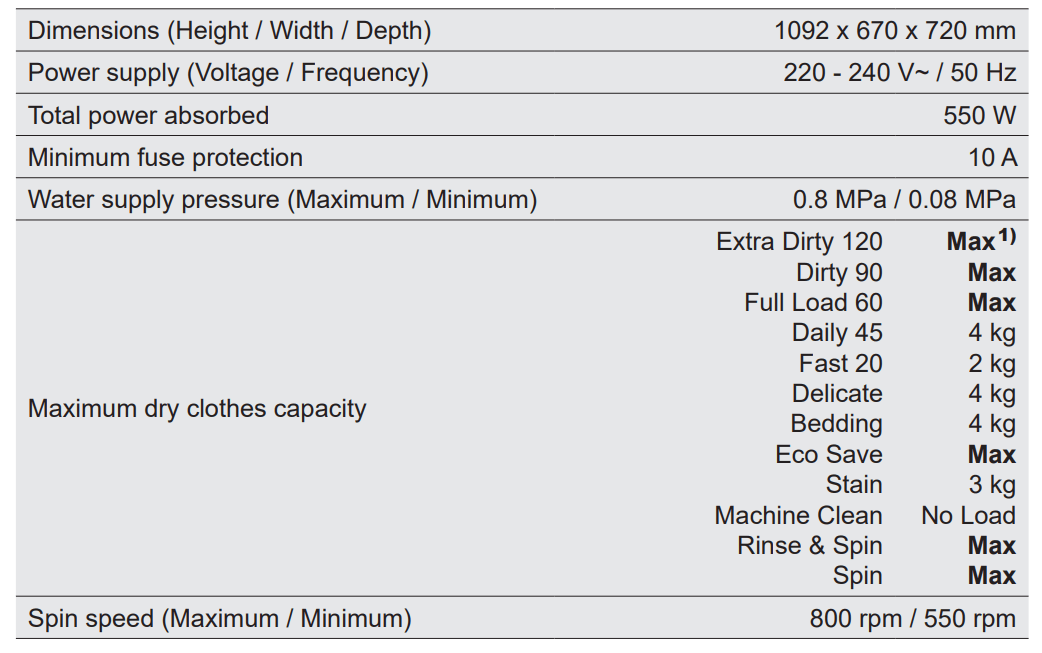
1) Maximum capacity depended on the model of the Washing Machine
- WWT8084J7WA 8 kg
- WWT9084C7WA 9 kg
- WWT1084C7WA 10 kg
- WWT1184C7WA 11 kg
INSTALLATION
Unpacking
- Use gloves. Remove the external film. If necessary, use a cutter.
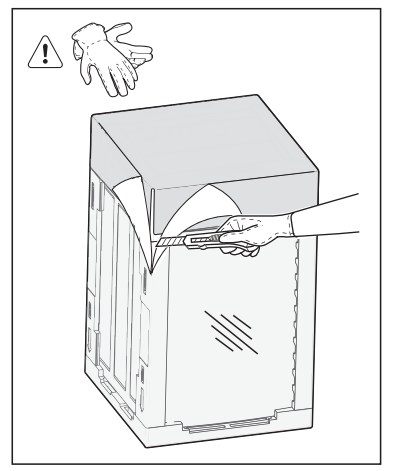
- Remove the plastic bag which covers the machine. Remove the polystyrene piece.
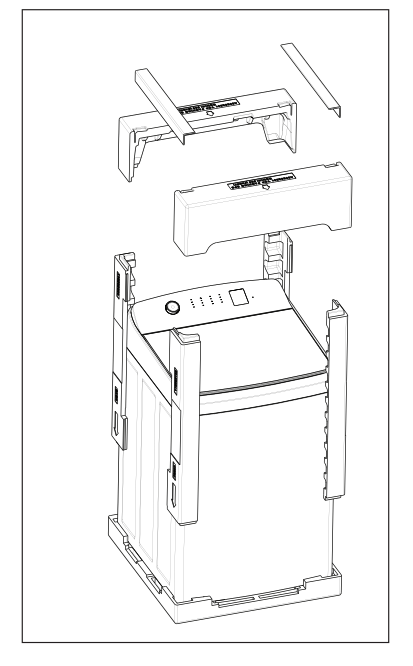
- Put one of the polystyrene packaging elements on the floor behind the appliance. Carefully put down the appliance with the rear side on it. Make sure not to damage the hoses.
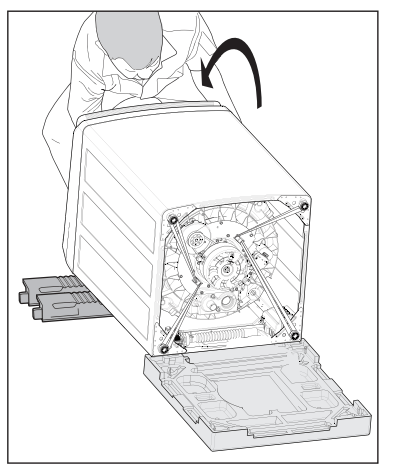 Caution: Pay attention to the machine lid, may hit your body.
Caution: Pay attention to the machine lid, may hit your body. 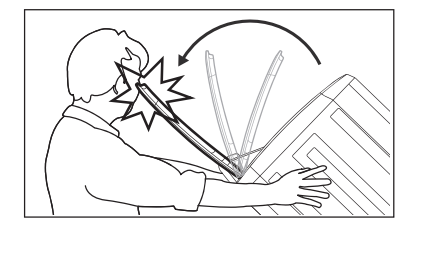
- Cut and remove straps as shown.

- Remove the polystyrene base
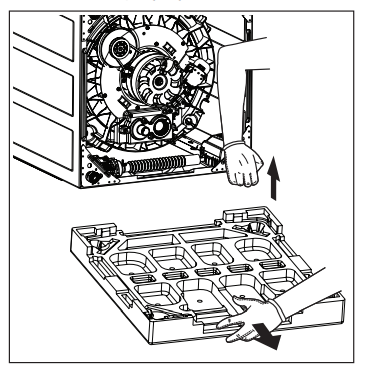
- Open the lid. Remove the polystyrene piece from the top panel and all the items from the washing tub
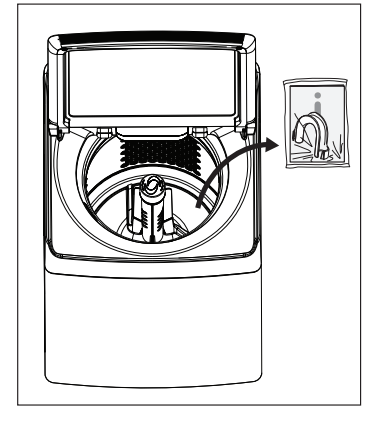
Positioning
- It is important that your washing machine stands firm and level on the floor to ensure correct operation.
- Use a spirit level on the front and side panels of the washing machine to check the levels. The spirit level should be used close to the corners of the washing machine for accuracy. By hand, or using a spanner if necessary, adjust the back legs first then the front.
- Adjust the four legs up or down as required. You machine may have adjustable legs with a stepped base. If so, please use either a 38 mm or 25 mm spanner or adjust them by hand.
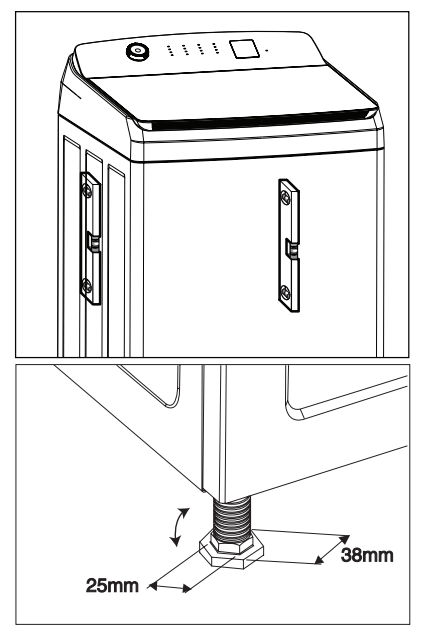
- If you do not have spirit level, as a guide use the edge of a door frame, cupboard or bench to check that the washing machine is level.
- Never place cardboard, wood or similar materials under the machine to compensate for any unevenness in the floor.
- Install the machine on a flat hard floor. Make sure that air circulation around the machine is not impeded by carpets, rugs etc. Check that the machine does not touch the wall or cupboard units.
- When the washing machine is levelled, try to rock it from corner to corner. If it does rock, adjust the legs again until it is levelled and does not rock.
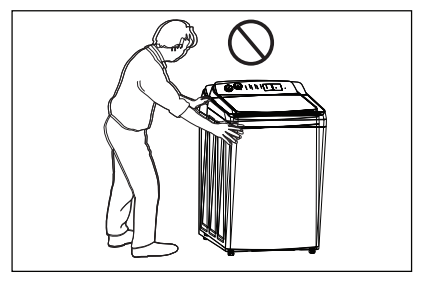
Water Inlet
- Connect the water inlet hose to a tap with 3/4” BSP thread.
- When installing this washing machine, use the hoses supplied. DO NOT USE OLD HOSES. The inlet hoses have the sealing washer fitted.
- Connect the inlet hose to the water tab. Make sure the connections are tight.
- Turn the taps on and check that there are no leaks from the connections.
- Turn off the water taps and move the washing machine into its final position. Make sure that the inlet and drain hoses do not kink.
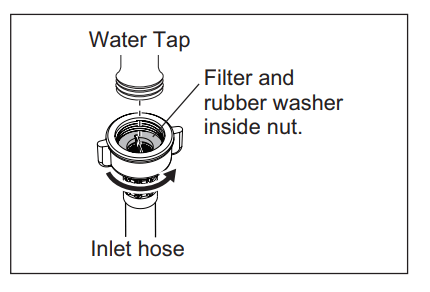
Water Drainage
- Fitting hose former. Obtain hose former from inside the washbowl and fit it to the drain hose.

- Positioning of drain hose. Adjust the free length of hose to suit your installation. It is important that the top of the drain hose is above the joint between the washing machine cabinet and the top panel (see picture).
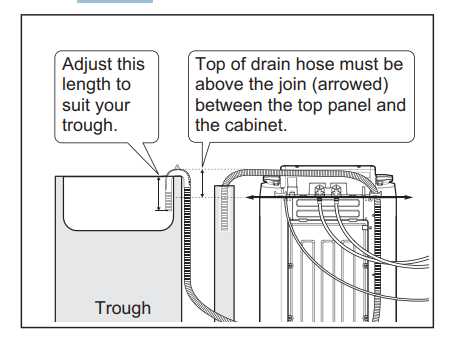
Electrical Connection
- This machine is designed to operate on a 220 - 240 V, single-phase, 50 Hz supply. “An incorrect power supply may void your warranty.”
- Check that your domestic electrical installation can take the maximum load required (2.0 kW), also taking into account any other appliances in use.
- Connect the machine to an earthed socket outlet.
- The manufacturer declines any responsibility for damage or injury through failure to comply with the above safety precaution.
- Should the appliance power supply cable need to be replaced, this shall be carried out by our Service Centre.
- When the appliance is installed, the power supply cable must be easily accessible.
See other models: WWT7084J5WA PXR688S WFG617SAWRC613SB WTB2300PC WTB2500WF
